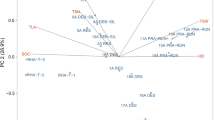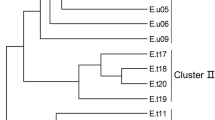Abstract
Eighteen microsatellite markers were used to determine the genetic distances between the parental gametophyte clones of 14 Laminaria hybrids, which were then used to establish a linear relationship with the heterosis (hybrid vigor) of economic traits including yield, mean blade try weight, mean blade fresh weight, blade length, blade width and mean blade thickness using regression analysis. Significant regression was found between the genetic distance (x) and the heterosis (y) of yield (y = 115.10x − 77.97, r = 0.8151, p = 0.00038), mean blade dry weight (y = 115.23x −77.97, r = 0.8154, p = 0.00038), mean blade fresh weight (y = 100.08x − 57.85, r = 0.7306, p = 0.0030) and blade length (y = 204.11x − 46.77, r = 0.6963, p = 0.00566). The prediction of the heterosis of Laminaria hybrids with the genetic distance between parental gametophyte clones will facilitate the selection of elite Laminaria hybrids by avoiding the time-consuming and labor-intensive trait evaluation of a large number of hybridization combinations.

Similar content being viewed by others
References
Bassam BJ, Caetano-Anolles G, Gresshoff PM (1991) Fast and sensitive silver staining of DNA in polyacrylamide gels. Anal Biochem 19:680–683
Druehl LD, Collins JD, Lane CE, Saunders GW (2005) An evaluation of methods used to assess intergeneric hybridization in Laminaria using Pacific Laminariales (Phaeophyceae). J Phycol 41:250–262
Evans LV (1965) Cytological studies in the Laminariales. Ann Bot 29:541–542
Fang TC, Ou YL, Cui JJ (1985) Breeding of hybrid Laminaria “Danza No 10”—an application of the Laminaria haploid cell clones. J Shandong Coll Oceanol 15:64 − 72 (in Chinese with English abstract)
He YJ, Zou YP, Wang XD, Zheng ZG, Zhang DM, Duan DL (2003) Assessing the germplasm of Laminaria (Phaeophyceae) with random amplified polymorphic DNA (RAPD) method. Chin J Oceanol Limnol 21:141–148
Lane CE, Mayes C, Druehl LD, Saunders GW (2006) A multi-gene molecular investigation of the Laminaria (Laminariales, Phaeophycear) supports substantial taxonomic re-organization. J Phycol 42:493–512
Li Z, Pinson SRM, Paterson AH, Park WD, Stansel JW (1997) Genetics of hybrid sterility and hybrid breakdown in an intersubspecific rice (Oryza sativa L.) population. Genetics 145:1139–1148
Li DP, Zhou ZG, Liu HH, Wu CY (1999) A new method of Laminaria japonica strain selection and sporeling raising by the use of gametophyte clones. Hydrobiologia 398/399:473−476
Li Z, Zhang Q, Yang Y, Xie J, Luo S (2003a) Study on the technique of large-scale culture of the clone of Laminaria gametophyte. Shandong Fisheries 20(5):1–3 (in Chinese)
Li D, Wu C, Liu W, Zang K, Xia J (2003b) A new technology of Laminaria japonica sporeling culture by the use of gametophyte clones. Acta Oceanol Sinica 25(5):141–145
Li XJ, Cong YZ, Yang GP, Qu SC, Li ZL, Wang GW, Zhang ZZ, Luo SJ, Dai HL, Xie JZ, Jiang JL, Wang TY (2007) Trait evaluation and trial cultivation of Dongfang No.2, the hybrid of a male gametophyte clone of Laminaria longissima (Laminariales, Phaeophyta) and a female one of L. japonica. J Appl Phycol 19:139–151
Scoggan S, Zhuang Z, Wang F (1989) Laminaria Seafarming in China: Training Manual 89/5 (RAS/86/024). Qingdao, China.
Shi CJ, Hu ZM, He YJ, Zou YP, Zhang DM, Duan DL (2005) Identification and assessing the cultivars of Laminaria Lamx. (Phaeophyceae) with molecular markers. J Integr Plant Biol 47(3):283–291
Shi YY, Yang GP, Liu YJ, Liao MJ, Li XJ, Cong YZ (2007) Development of 18 polymorphic microsatellite DNA markers of Laminaria japonica (Phaeophyceae). Mol Ecol Notes 7:620–622
Shikano T, Taniguchi N (2002) Using microsatellite and RAPD markers to estimate the amount of heterosis in various strain combinations in the guppy (Poecilia reticulata). Aquaculture 204:271–281
Syed N, Chen ZJ (2005) Molecular marker genotypes, heterozygosity and genetic interactions explain heterosis in Arabidopsis thaliana. Heredity 94:295–304
Tom DI (1992) North Pacific and North Atlantic digitata Laminaria species (Phaeophyta) hybridization experiment and temperature response. Phycologia 31:147–163
Tseng CK (2001) Algal biotechnology industries and research activities in China. J Appl Phycol 13:375–380
Tseng CK, Sun KY, Wu CY (1955) On the cultivation of Haidai (Laminaria japonica Aresch) by summering young sporophytes at low temperature. Acta Bot Sinica 4(3):255–264
Tseng CK, Wang S, Liu SJ, Guo XK, Zhang DM, Miao GR (1984) Cultivation of Microalgae. Shanghai Science and Technology Press, Shanghai, China, pp 87–92
Wang SJ (1994) Seaweed biotechnology. Shanghai Science and Technology Press, Shanghai, China, pp 104–111
Wang XL, Yang YX, Cong YZ, Duan DL (2004) DNA fingerprinting of selected Laminaria (Phaeophyta) gametophytes by RAPD markers. Aquaculture 238:143–153
Wang GG, Li YH, Xia P (2005) A simple method for DNA extraction from sporophyte in the brown alga Laminaria japonica. J Appl Phycol 17:75–79
Wu CY, Lin GH (1987) Progress in the genetics and breeding of economic seaweeds in China. Hydrobiologia 151/152:57–61
Yang Z (1997) Breeding of widely compatible restorer lines in rice (Oryza sativa L.) through anther culture. Euphytica 95:253–258
Yeh FC, Yang R, Boyle TJ, Ye Z, Xiyan JM (2000) POPGENE 32, Microsoft Windows-based freeware for population genetic analysis. Molecular Biology and Biotechnology Centre, University of Alberta, Edmonton, Canada
Yoon HS, Lee JY, Boo SM, Bhattacharya D (2001) Phylogeny of Alariaceae, Laminariaceae and Lessoniaceae (Phaeophyceae) based on plastid-encoded RuBisCo spacer and nuclear-encoded ITS sequence comparisons. Mol Phylogenet Evol 21:231–243
Yotsukura N, Denboh T, Motomura T, Horiguchi T, Coleman AW, Tchimura T (1999) Little divergence in ribosomal DNA internal transcribed spacer -1 and -2 sequences among non-digitate species of Laminaria (Phaeophyceae) from Hokkaido, Japan. Phycol Res 47:71–80
Yu SB, Li JX, Xu CG, Tan YF, Gao YJ, Li XH, Zhang QF, Saghai-Maroof MF (1997) Importance of epistasis as the genetic basis of heterosis in an elite rice hybrid. Proc Natl Acad Sci USA 94:9226–9231
Zemke-White WL, Ohno M (1999) World seaweed utilization: An end-of-century summary. J Appl Phycol 11:369–376
Zhang Z, Fan C, Cao S, You X, Su Y (1999) Study on interspecific crossing of Laminaria species. J Dalian Fisheries Univ 14(4):13 – 17 (in Chinese with English abstract)
Zhang QS, Tang XX, Zhang PY, Qu SC, Li XJ (2005) Study on seedling collection technology in the production of Laminaria gametophyte clone. High Tech Lett 15:89–92
Zhang QS, Tang XX, Cong YZ, Qu SC, Luo SJ, Yang GP (2007) Breeding of an elite Laminaria variety 90–1 through inter-specific gametophyte crossing. J Appl Phycol 19:303–311
Acknowledgement
This study was supported by The Key Laboratory of Mariculture of Chinese Ministry of Education, Ocean University of China (200405), and Provincial Department of Science and Technology of Shandong (No. 2005GG3205190).
Author information
Authors and Affiliations
Corresponding author
Rights and permissions
About this article
Cite this article
Li, X., Yang, G., Shi, Y. et al. Prediction of the heterosis of Laminaria hybrids with the genetic distance between their parental gametophyte clones. J Appl Phycol 20, 1097–1102 (2008). https://doi.org/10.1007/s10811-008-9321-9
Received:
Revised:
Accepted:
Published:
Issue Date:
DOI: https://doi.org/10.1007/s10811-008-9321-9




